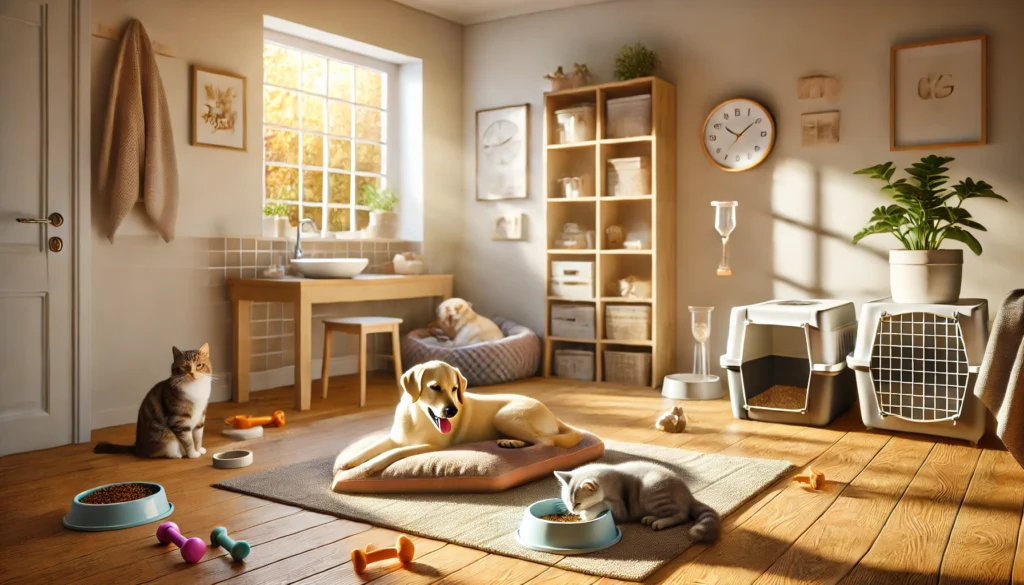Building a daily routine for your pets is more than just convenience — it’s a foundation for their emotional security, physical health, and overall happiness. Dogs and cats, though different in their needs, both benefit greatly from structure and consistency. In this guide, we’ll walk through an ideal daily routine that you can adapt to your lifestyle while making your furry friends feel loved and well cared for.
Morning Routine: A Calm and Healthy Start
1. Greet Your Pets Warmly
Start the day with a gentle interaction. Dogs may be wagging their tails, eager to go outside, while cats might stretch and approach you slowly.
- Speak to them softly
- Offer cuddles or scratches if they’re receptive
- Keep the mood calm to prevent overstimulation
2. Morning Potty Time
Dogs will likely need a bathroom break first thing. If you have a yard or walk them outside, this is the time.
- Take them out for a short walk or to their designated spot
- For indoor cats, ensure the litter box is clean and ready
- Observe any unusual behavior like straining or avoiding the bathroom area
3. Feed Breakfast
Feeding at a consistent time each morning helps regulate digestion and reduces anxiety around food.
- Use clean bowls and fresh water
- Offer balanced, age-appropriate food
- Keep cats’ bowls in a separate area if needed to prevent competition
Midday Activities: Mental and Physical Engagement
4. Play and Exercise
Especially important for dogs, and often overlooked for indoor cats, midday stimulation is crucial.
- Quick play sessions (fetch, tug-of-war, laser pointer)
- Puzzle feeders to combine play and feeding
- Cat towers or window perches for environmental enrichment
5. Midday Potty Break (For Dogs)
If possible, allow dogs out again for a short bathroom break. If you’re away, consider a trusted dog walker or pet-friendly indoor potty options.
6. Rest and Relaxation Time
Pets need downtime too. Most will naturally nap during the late morning or early afternoon.
- Provide cozy beds or blankets in a quiet space
- Avoid loud noises or disruptions during their nap
- Keep windows open (safely) for fresh air and natural light
Afternoon Routine: Reset and Light Interaction
7. Refresh Food and Water
Check that your pets’ bowls are clean and replenished.
- Add fresh water if needed
- Remove uneaten food if it’s been sitting out
- Offer a light snack or treat if part of your routine
8. Grooming and Hygiene
Short grooming sessions keep your pets clean and help you monitor their health.
- Brush their fur gently (especially long-haired breeds)
- Wipe paws if they’ve been outside
- Quick check of ears, eyes, and nails
9. Litter Box or Potty Check
Scoop the litter box again in the afternoon, and for dogs, offer another chance to go outside if you’re home.
Evening Routine: Wind Down the Day
10. Evening Walk and Play
Dogs benefit from a longer walk in the evening to release energy and help them sleep better. Cats also enjoy evening play sessions due to their natural hunting instincts at dusk.
- Play interactive games like chase, hide and seek, or wand toys
- For dogs, explore new walking paths or play in the yard
- Mix physical and mental activity to tire them out in a healthy way
11. Dinner Time
Evening feeding keeps your pets satisfied overnight.
- Stick to a similar portion as breakfast
- Maintain calm and consistent feeding habits
- Avoid high-sugar or overly fatty treats close to bedtime
12. Quiet Time and Bonding
As the day slows down, give your pets your undivided attention.
- Sit together on the couch or bed
- Offer belly rubs, brushing, or simply sit quietly near them
- Speak gently — this creates a feeling of safety and love
13. Final Potty Break and Bedtime Prep
Before you sleep, take your dog out one last time. For cats, check the litter box and make sure their space is clean.
- Check that water is full
- Turn down lights
- Ensure they’re in a secure, quiet space for sleeping
Creating Flexibility Within Routine
Life isn’t always predictable, and your routine doesn’t have to be rigid. What’s important is consistency in key actions — feeding, bathroom breaks, exercise, and affection.
- Be patient when routines are disrupted
- Use gentle training to reinforce positive behaviors
- Adjust the schedule over time to meet evolving needs (age, health, energy levels)
The Power of Daily Rituals
Routines build trust. When your dog knows what comes next, they feel confident. When your cat has a predictable rhythm, they’re less stressed. Pets don’t need fancy toys or constant attention — they need your consistency, time, and care.
By creating an intentional daily routine, you give your pets the gift of stability, which directly affects their quality of life. It’s not about perfection, it’s about presence — and pets know when they are loved.






